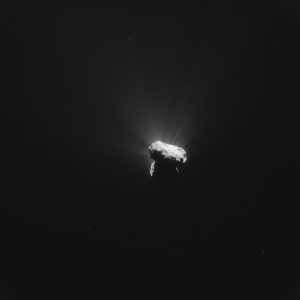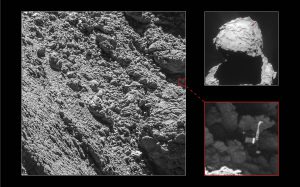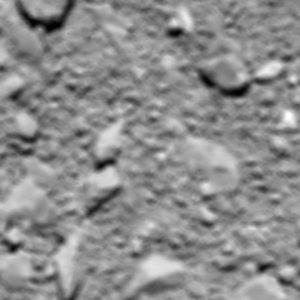Comet Landing 2.0
During my ongoing literature review I often discover interesting facts about things I’ve never thought about. Sometimes I can connect these facts with my own observations: The result is mostly a completely new idea why things are as they are. Maybe these ideas are new to you, too. Therefore I’ll share my new science based knowledge with you!
This week: This time, I think about Rosetta’s landing on Comet 67P/Churyumov-Gerasimenko.
On 6 August 2014, we all cheered as Rosetta became the first spacecraft that successfully entered into an orbit around a comet. That day, the European Space Agency’s orbiter arrived at Comet 67P/Churyumov-Gerasimenko after a 10-year long journey through our solar system. Throughout this long journey, Rosetta did three Earth and one Mars gravity assists in order to accelerate to a speed that allowed it to ultimately rendezvous with the comet.
Only three months later, on 12 November 2014, we all cheered again as the small lander ‚Philae‘ that was riding piggyback on Rossetta seperated from the orbiter and began its 7-hour long descent to the surface of the comet. It was the first attempt ever to soft-land a spacecraft on the surface of a comet in order to analyze some surface samples and to take close-up pictures of the comet’s surface. Despite experiencing some technical issues that resulted in the lander bouncing across the surface, the landing was a success. Unfortunately, Philae landed in a spot that provided not enough sunlight to keep the lander’s batteries charged, but the spacecraft managed to carry out 80% of the planned experience before it ran out of electric charge.

Comet at perihelion, Copyright ESA/Rosetta/NAVCAM – CC BY-SA IGO 3.0
Since then, Rosetta continued to orbit Comet 67P in order to analyze the comet and to collect valuable data that already allowed scientists to learn more about the formation of our solar system. In addition, the orbiter observed the changes in the comet’s activity as it got closer to the sun. On 13 August 2015, the comet arrived at its perihelion and began to increase the distance to the sun again. Recently, on 2 September 2016, Rosetta managed to find Philae on the comet’s surface, thus allowing the scientists to put its condition into perspective.

Philae found, Copyright Main image and lander inset: ESA/Rosetta/MPS for OSIRIS Team MPS/UPD/LAM/IAA/SSO/INTA/UPM/DASP/IDA; context: ESA/Rosetta/NavCam – CC BY-SA IGO 3.0
Unfortunately, the Rosetta mission had to come to an end on 30 September 2016 because the spacecraft was getting farther and farther away from the sun. Soon, the reduced amount of sunlight would not have been enough to generate the power needed to keep the spacecraft running. However, instead of letting the orbiter slowly die, the Rosetta scientists decided to end the mission with a grand finale: a landing on the surface of the comet. During the final approach, Rosetta was collecting as much data as possible in order to provide the scientists with insights into the atmosphere of the comet as well as with spectacular close-up pictures as the spacecraft got closer and closer to the surface.
In order to make sure that the spacecraft would be passivated after the landing, the engineers uploaded a final patch during Rosetta’s last days that ensured that the spacecraft will shut down as soon as it measures a drastic change in its attitude due to the contact with the surface.
For the last time, on 30 September 2016, we all cheered for the orbiter that has achieved so many milestone and we eagerly expected the last set of images from Rosetta that provided new and spectacular insights into the surface structure of the comet. Finally at 13:19 CEST, the signal to Rosetta was lost. Due to the huge distance of 4.81 AU to the spacecraft, the signal had a delay of 40 minutes and hence the landing must have occured around 12:39 CEST.

Rosetta’s last image, Copyright ESA/Rosetta/MPS for OSIRIS Team MPS/UPD/LAM/IAA/SSO/INTA/UPM/DASP/IDA
Rosetta achieved a lot of milestones and inspired many people all around the world. Now, the orbiter came to its final rest and is basically reunited with Philae.
Thank you Rosetta, thank you ESA!